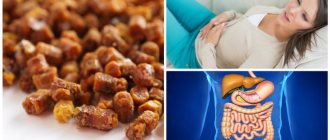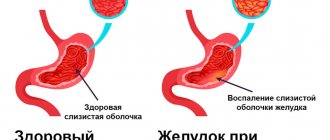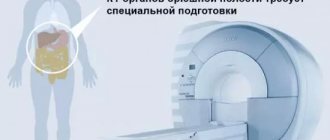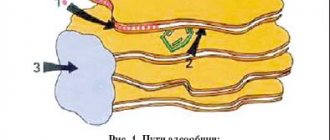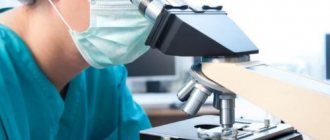Esophageal dyskinesia
The hypermotor variant of the pathology is characterized by an increase in tone and motor activity not only during swallowing food, but also outside of it. In every tenth patient, this type of dyskinesia does not have a pronounced clinical picture; this pathology can be identified only during a random examination of the patient for another reason. The remaining patients have unstable dysphagia (periods of remission can reach several months), aggravated by smoking, abuse of alcohol, spices, too hot food and drinks, and stress.
Chest pain usually occurs against a background of complete health, and is similar in intensity and radiation to pain during angina pectoris (a distinctive feature is that it is not associated with physical activity). With severe spasm of the esophagus, there may be a feeling of a lump or foreign body in the esophagus. A feature of segmental spasm of the esophagus is the difficulty of passing semi-liquid foods and foods rich in fiber (sour cream, juices, bread, fruits and vegetables) into the stomach; the pain is moderate, without irradiation, and has a gradual onset and end.
Diffuse esophagospasm is characterized by very severe chest pain, radiating throughout the entire anterior surface of the chest, into the epigastric region, shoulders and jaw. The pain syndrome can occur either during food intake or suddenly, usually lasts a long time, and is sometimes relieved by a sip of water. After the end of the attack, regurgitation of gastric contents is noted. Dysphagia is usually constant, more pronounced when passing liquid food and almost unnoticeable when swallowing solid food.
Against the background of preserved esophageal peristalsis, nonspecific dyskinesia is recorded: pain appears irregularly, is localized in the middle or upper part of the sternum, is associated with food intake, and is short-lived. They usually stop on their own. Dysphagia is uncommon. The hypermotor type of the disease should be differentiated from esophageal cancer, GERD, achalasia cardia, and coronary heart disease.
Primary hypomotor esophageal dyskinesia is very rare and is mainly associated with age and alcohol abuse. Often accompanied by reflux esophagitis. In every fifth case, this type of dyskinesia is asymptomatic; in the rest, dysphagia, a feeling of fullness and heaviness in the stomach after eating, regurgitation of gastric contents, and esophagitis are recorded.
Disturbances in the functioning of the esophageal sphincters include cardiospasm, achalasia of the cardia, and disturbances in the contraction of the upper sphincter. Cardiospasm (spasm of the lower esophageal sphincter) is characterized by an increase in the tone of the lower parts of the esophagus and difficulty in passing food through its lower sphincter. Patients with this pathology are emotionally labile and irritable, complaining of a sensation of a lump or foreign body in the throat, aggravated by swallowing and excitement, accompanied by a feeling of lack of air and a burning sensation in the chest. If increased motility extends to the stomach, heartburn and belching are bothersome.
Achalasia cardia differs from cardiospasm by a decrease in the tone of the lower parts of the esophagus against the background of difficulty in passing food through the lower sphincter. Dysphagia is provoked by stress, rapid absorption of food, and certain foods. Characterized by a feeling of fullness and pressure in the stomach and behind the sternum, regurgitation of eaten food, pain in the sternum. Often accompanied by esophagitis. Disorders of contraction of the upper sphincter are rare and are expressed in swallowing disorders and esophagopharyngeal regurgitation.
Causes of reflux esophagitis
The disease develops due to contact of the contents of the stomach and duodenum with the mucous membrane of the esophagus, which occurs when the lower esophageal sphincter, located at the border of the stomach and esophagus, is incompetent. As a result of impaired motility of the organs of the gastroesophageal zone, acidic gastric contents, being in the esophagus for a certain time, damage the cells of the mucosa.
Factors contributing to the development of reflux esophagitis are hiatal hernia - hiatal hernia, excess weight, pregnancy, leading to increased intra-abdominal pressure, taking certain medications, and smoking.
You can ask questions and sign up for a consultation by phone: +7 (495)222-10-87
or fill out the form below
Thank you, your question has been sent successfully, we will contact you soon!
Ask a new question
Classification
To assess the patient’s condition and unify data, a classification is used; depending on the degree of damage to the esophagus, several stages of reflux esophagitis are distinguished.
- I - rounded and longitudinal delimited, non-merging foci of inflammation, spreading to the mucous membrane of the esophagus from the Z-line - the border of the transition of the multilayered squamous epithelium of the esophageal mucosa into the columnar epithelium of the gastric mucosa;
- II - lesions in the Z-line zone merge, but do not cover the entire circumference of the esophagus;
- III - merging lesions covering the entire surface of the mucosa;
- IV - chronic damage to the esophagus, in which fibrous stenosis, shortening of the esophagus, peptic ulcers, and Barrett's esophagus develop.
To determine the stage of reflux esophagitis, it is necessary to undergo an examination, based on the results of which treatment is prescribed.
Features of nutrition for hypermotor dyskinesia
Kissel slows down the progress of the food bolus.
With increased intestinal motility, the main goal of the diet is to provide the body with mineral salts, vitamins, proteins, fats and carbohydrates that are missing due to too rapid bowel movements and frequent diarrhea.
For these purposes, it is recommended to give up vegetables in the first stages of the diet, since a large amount of fiber stimulates motor skills and causes painful spasms.
They begin to be introduced into the diet after a persistent improvement in health, preferably in boiled form, as well as in the form of juices (from a quarter to half a glass 2-3 times a day). Foods and dishes to slow down intestinal motility:
- Mucous soups, pureed porridges, jelly are the best astringents for slowing down the movement of the food bolus without irritating the intestinal mucosa.
- Compotes and baked desserts from pears, bird cherry, quince, blueberry, dogwood. The tannins contained in these berries and fruits bind and firm the stool. In their raw form, these products have the opposite effect, stimulating peristalsis.
- Strong green tea.
- Side dishes and dishes made from rice and semolina.
To slow down peristalsis, it is advisable to eat food warm. A slag-free diet with minimal fiber content and a high concentration of vegetable fats will help treat hypermotor dyskinesia. Prohibited foods for increased peristalsis:
- Fatty meats (pork, lamb, beef, goose, duck);
- Fatty fish (mackerel, salmon, sturgeon);
- Baking, white bread;
- Foods high in starch;
- Products that cause gas formation and irritate the mucous membrane (white cabbage, radish, peas, radishes, onions, garlic);
- Carbonated drinks, alcohol in any form;
- Fried, smoked, canned, pickled foods.
- Hot seasonings, spices (mustard, horseradish, pepper, adjika).
Diagnostics
There are various diagnostic methods that can accurately determine the degree of damage to the esophagus. This is evidenced by the presence of changes due to the inflammatory process, erosions, ulcers, strictures, and metaplasia. The main diagnostic methods include:
- Fibrogastroscopy is an examination of the upper parts of the gastrointestinal tract using endoscopic equipment; during the procedure, it is possible to identify abnormalities in the wall of the esophagus, assess the condition of the mucous membrane, and exclude or confirm diseases of the stomach and duodenum. During the examination, a biopsy can be performed - taking tissue particles from visible pathological areas for the purpose of further histological examination.
- X-ray examination allows you to detect a stricture of the esophagus, ulcerative lesions, hiatal hernia, its size, it is also possible to assess the motility of the esophagus and stomach, the presence of reflux during examination using a barium suspension.
- Daily pH-metry - determination of the level of gastric secretion and the presence of reflux; it is possible to estimate the duration of reflux episodes, which allows you to select therapy and monitor the effectiveness of the drugs used.
- Esophageal manometry is an examination that allows you to determine the tone of the esophageal sphincters and their patency based on measuring pressure in different parts.
- pH impedansometry is a study aimed at assessing esophageal peristalsis and differentiation of gastroesophageal reflux, which is important for determining the nature of the disease and its cause.
Depending on the presence of certain symptoms, other examinations may be prescribed: ultrasound, ECG, consultation with an otolaryngologist, etc. In our clinic, patients have access to all the necessary diagnostic procedures, the examination takes a minimum of time.
Treatment
Conservative treatment is indicated for patients with mild manifestations. Drug therapy can be aimed at neutralizing the contents thrown from the stomach into the esophagus, reducing gastric acidity, and protecting the esophageal mucosa.
There are various drugs: antisecretory agents, prokinetics and antacids, but they can only eliminate the symptoms. At the end of the course of treatment, signs of the disease return again. It is also worth considering that long-term use of medications that suppress the production of gastric juice can lead to poor digestion of food, which will lead to a number of disorders. When using medications that affect acidity, the risk of malignancy increases.
Features of nutrition for hypomotor dyskinesia
Dried fruits stimulate intestinal function.
Since the main goal of this type of diet is to stimulate motility and speed up bowel movements, it is important to include certain dishes in the menu.
Despite the restrictions, such a diet must take into account all the needs of the body. Foods and dishes that stimulate bowel function:
- fresh, baked, stewed, steamed
- vegetables, greens;
- fresh fruits, berries, apples are especially useful;
- dried fruits;
- hard-boiled eggs (no more than 2 pieces per day);
- wholemeal bread;
- dairy products;
- first courses, mainly cooked in vegetable broth (borscht, pickles, cereal-based soups);
- well-boiled porridge cooked in water;
- lean varieties of veal, beef, rabbit, chicken,
- turkey, offal, sea and river fish;
- natural butter, vegetable oils;
- sweets in minimal quantities (honey, jelly, jam, ice cream);
It is very useful to add bran from various cereal crops (wheat, buckwheat, rye) to the first and second courses in courses of 6 weeks. They are poured with boiling water in advance or mixed with soups and side dishes. Bran helps to establish regular bowel movements. For the same purposes, it is recommended to eat cold food.
Spices are added to dishes in moderation. Recommended drinks are kvass, weak black and green tea. It is undesirable to consume foods that stimulate fermentation and rotting of food, or foods that remain in the digestive tract for a long time. Prohibited products:
Sample menu
The morning should start with cottage cheese.
Taking into account the above recommendations, it is not difficult to create a menu for intestinal dyskinesia.
- Morning - porridge with water, salad of boiled vegetables or cottage cheese with sour cream, or buckwheat porridge with dried fruits. Drinks – tea with dried bread, fermented baked milk.
- Second breakfast - fresh fruit or compote, jelly.
- Lunch - vegetable soup with cereals or vegetarian noodle soup, for the second - vinaigrette with vegetable oil or stewed fish with vegetables, for the third - dried fruit compote, jelly.
- Afternoon snack – fresh fruit, compote with dry cookies, biscuits, crackers.
- Dinner – buckwheat or millet porridge, steamed omelette, tea with bread.
- Snack before bed - kefir with soaked dried apricots or prunes.
The correct selection of dishes, careful selection of products that correspond to the type of dyskinesia will significantly improve the patient’s well-being, eliminate negative symptoms of the disease, normalize weight, and improve metabolism.
